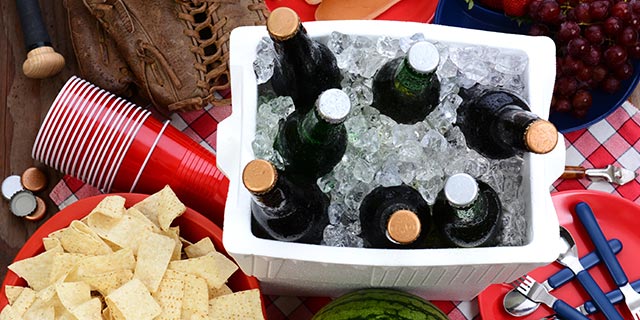Summer Cooler Safety

Summer is officially here and the perfect time for picnics – picnics in the park, picnics at the lake, picnics, picnics, picnics! When we think of preparing for a picnic, what is the essential item that every picnic needs? That’s right – a cooler! I’m here today to provide you with some tips to keep your picnic food safe utilizing your cooler.
Keeping in mind the 4 core food safety principles of COOK, CHILL, CLEAN and SEPARATE, all can apply in regards to your cooler with the exception of COOK.…..coolers do not make good cooking vessels – unless there is some new trend I haven’t heard about!
First off let’s look at CLEAN
Ensuring that the cooler is clean is the best first step, especially if you are using it to hold ice for beverages. If the cooler will be used as an “ice bucket”, you will want to completely wash the inside of the cooler with hot soapy water and rinse thoroughly prior to filling with ice for consumption. *The only reason I bring this up is because I have seen this happen and it is important for everyone to remember that ice is also a food. Coolers used for this purpose must be cleaned the same as washing an eating utensil and used ONLY for ice. If storing beverages and/or food products on ice, you do not want to consume this ice. The better option is to buy packaged ice and keep the package securely closed in between uses.
Secondly, let’s talk about SEPARATE
If transporting raw meat items in the cooler, it is best that you use two separate coolers to eliminate the risk of cross contamination between raw and ready-to-eat foods. Also, it is often best to keep beverages in their own separate cooler as well. On a hot summer day, the beverage cooler is typically the “go-to cooler” many times throughout the day. Frequent openings of the cooler can cause the contents to warm up quickly. Beverages are typically items that do not need to be kept cold for food safety reasons with the exception of dairy products; therefore, a beverage such as milk should be kept in the “food” cooler.
Lastly, the CHILL
Potentially hazardous foods or those that need temperature control for safety – meats, dairy products, cut fruits and veggies all need to be kept at 41 F or below. This is sometimes difficult to do with a cooler, especially for an extended period of time. Placing these food items in tightly sealed plastic bags and then surrounding them with ice will certainly help keep them cold. Ice packs and frozen foods can also be used. Make sure you are using an insulated cooler and save the packing of the food cooler until last – straight from the refrigerator into the cooler into the car. At the picnic site, keep the coolers out of direct sunlight and replenish the ice when needed.
I hope you will find these cooler tips helpful and you keep them in mind as we step full swing into summer, which means… Great opportunities for picnics!
Kim
Food Safety Mgr